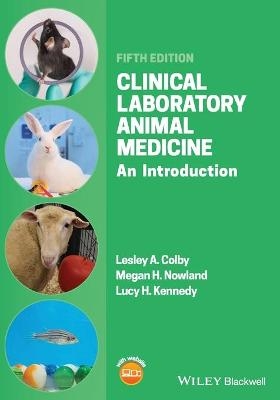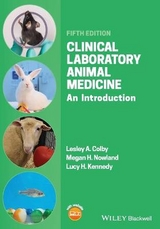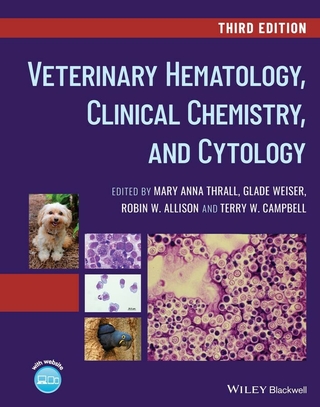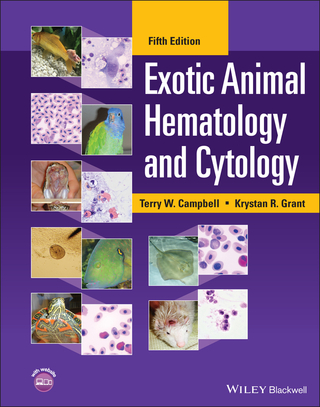Clinical Laboratory Animal Medicine
Wiley-Blackwell (Verlag)
978-1-119-48956-6 (ISBN)
The updated fifth edition adds two new chapters on zebrafish and large animals, new information on transgenic models and genetic editing, and expanded coverage of environmental enrichment and pain management. The book presents helpful tip boxes, images, and review questions to aid in comprehension and learning, and a companion website provides editable review questions and answers, instructional PowerPoints, and additional images not found in the book.
This important text:
- Provides a complete introduction to laboratory animal husbandry, diseases, and treatments
- Offers a user-friendly format with helpful content that highlights important concepts
- Contains new knowledge relating to technical methodologies, diseases, drug dosages, laws and regulations, and organizations
- Covers information on regulations, facilities, equipment, housing, and research variables as well as veterinary care
- Includes new chapters on zebrafish and cattle, sheep, goats, and pigs
Written for veterinary technicians, veterinary students, practicing veterinarians, and research scientists, the fifth edition of »Clinical Laboratory Animal Medicine« continues to offer an essential guide to the ethical treatment and anatomic and physiological characteristics of research animals.
Lesley A. Colby, DVM, MS, DACLAM, is an Associate Professor and Senior Director of Animal Resources and Operations in the Department of Comparative Medicine at the University of Washington in Seattle, Washington, USA.
Megan H. Nowland, DVM, DACLAM, is an Associate Professor in the Unit for Laboratory Animal Medicine at the University of Michigan in Ann Arbor, Michigan, USA.
Lucy H. Kennedy, DVM, DACLAM, is an Assistant Professor in the Unit for Laboratory Animal Medicine at the University of Michigan in Ann Arbor, Michigan, USA.
About the Authors xii
Preface xiii
About the Companion Website xiv
1 Introduction to Laboratory Animal Medicine 1
Animals Used in Research, Teaching, and Testing 2
Ethical Considerations 8
Organizations 12
Bibliography 17
Further Reading 18
Chapter 1 Review 19
2 Regulations, Policies, and Principles Governing the Care and Use of Laboratory Animals 22
Animal Welfare Act and Regulations 22
Public Health Service Policy on Humane Care and Use of Laboratory Animals 28
Other Regulations, Policies, Guidance Documents, and Organizations 31
References 36
Further Reading 37
Chapter 2 Review 37
3 Facility Design, Housing, Equipment, and Management 39
Laboratory Animal Facility Design 39
Common Facility Classifications 46
Housing 50
Facility Equipment 59
Management 66
Bibliography 69
Further Reading 69
Chapter 3 Review 71
4 Mice 74
Genetics 74
Microbiologic Classifications 76
Uses 77
Behavior 77
Anatomic and Physiologic Features 78
Breeding and Reproduction 80
Husbandry 81
Techniques 86
Special Techniques: Transgenic Production Technology 96
Therapeutic Agents 101
Introduction to Diseases of Mice 101
Viral Diseases 107
References 114
Further Reading 119
Chapter 4 Review 122
5 Rats 124
Genetics 124
Microbiologic Classifications 125
Uses 126
Behavior 126
Anatomic and Physiologic Features 127
Breeding and Reproduction 129
Husbandry 130
Techniques 133
Therapeutic Agents 143
Introduction to Diseases of Rats 144
Bibliography 157
Further Reading 162
Chapter 5 Review 162
6 Gerbils 165
Uses 165
Behavior 166
Anatomic and Physiologic Features 166
Breeding and Reproduction 167
Husbandry 168
Techniques 170
Therapeutic Agents 176
Introduction to Diseases of Gerbils 176
Bibliography 181
Further Reading 183
Chapter 6 Review 184
7 Hamsters 185
Uses 185
Behavior 186
Anatomic and Physiologic Features 187
Breeding and Reproduction 189
Husbandry 190
Techniques 192
Therapeutic Agents 198
Introduction to Diseases of Hamsters 198
Bibliography 207
Further Reading 209
Chapter 7 Review 210
8 Guinea Pigs 212
Uses 212
Behavior 213
Anatomic and Physiologic Features 214
Breeding and Reproduction 216
Husbandry 218
Techniques 219
Therapeutic Agents 225
Introduction to Diseases of Guinea Pigs 226
Bibliography 238
Further Reading 240
Chapter 8 Review 242
9 Chinchillas 243
Uses 243
Behavior 244
Anatomic and Physiologic Features 244
Breeding and Reproduction 246
Husbandry 247
Techniques 249
Therapeutic Agents 253
Introduction to Diseases of Chinchillas 255
Bibliography 260
Further Reading 262
Chapter 9 Review 262
10 Zebrafish 264
Uses 264
Behavior 265
Anatomic and Physiologic Features 265
Reproduction and Life Stages 266
Husbandry 268
Techniques 274
Therapeutic Agents 278
Introduction to Diseases of Zebrafish 278
Bibliography 283
Further Reading 284
Chapter 10 Review 285
11 Rabbits 286
Breeds 286
Uses 287
Behavior 288
Anatomic and Physiologic Features 288
Breeding and Reproduction 291
Husbandry 293
Techniques 297
Therapeutic Agents 308
Introduction to Diseases of Rabbits 309
Bibliography 326
Further Reading 329
Chapter 11 Review 331
12 Ferrets 333
Uses 333
Behavior 334
Anatomic and Physiologic Features 334
Breeding and Reproduction 336
Husbandry 337
Techniques 339
Therapeutic Agents 347
Introduction to Diseases of Ferrets 347
Bibliography 365
Further Reading 369
Chapter 12 Review 369
13 Primates 371
Taxonomy 371
Uses 375
Behavior 376
Anatomic and Physiologic Features 377
Breeding and Reproduction 378
Husbandry 380
Techniques 383
Therapeutic Agents 390
Introduction to Diseases of Nonhuman Primates 390
Bibliography 410
Further Reading 413
Chapter 13 Review 416
14 Cattle, Sheep, Goats, and Pigs 417
Uses 417
Behavior 418
Anatomic and Physiologic Features 419
Breeding and Reproduction 419
Husbandry 420
Techniques 424
Therapeutic Agents 428
Introduction to Diseases of Agricultural Animals of Particular Importance to Research 428
Bibliography 434
Further Reading 435
Chapter 14 Review 435
15 Research Variables, Biosecurity, and Colony Health Surveillance 437
Research Variables 437
Biosecurity and Exclusion of Contaminants 445
Animal Colony Health Surveillance 448
Bibliography 455
Further Reading 455
Chapter 15 Review 456
Appendix 1: Normal Values 459
Appendix 2: Comparative Biologic and Reproductive Values by Species 464
Answers to Review Questions 467
Index 474
| Erscheinungsdatum | 27.11.2019 |
|---|---|
| Verlagsort | Hoboken |
| Sprache | englisch |
| Maße | 181 x 253 mm |
| Gewicht | 1056 g |
| Einbandart | kartoniert |
| Themenwelt | Veterinärmedizin ► Klinische Fächer ► Hämatologie |
| Veterinärmedizin ► Klinische Fächer ► Versuchstiere | |
| Veterinärmedizin ► Kleintier | |
| Weitere Fachgebiete ► Land- / Forstwirtschaft / Fischerei | |
| Schlagworte | Versuchstiere |
| ISBN-10 | 1-119-48956-3 / 1119489563 |
| ISBN-13 | 978-1-119-48956-6 / 9781119489566 |
| Zustand | Neuware |
| Haben Sie eine Frage zum Produkt? |
aus dem Bereich




